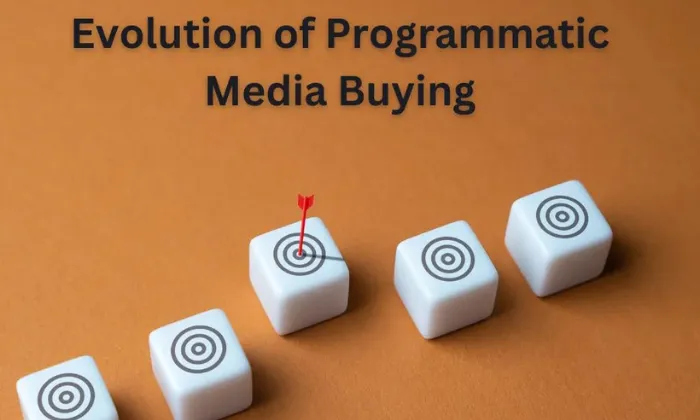With the advancement of technology, marketing has reached a new level. Advertisers are finding ways to reach their audience in a focused way rather than targeting them broadly. Consequently, advertisers are turning to programmatic advertising for its greater advancements. Let’s understand the evolution of programmatic media buying in this article and explore the most significant advancements in it.
What is Programmatic Advertising?
The central theme of programmatic advertising is the usage of automated technology, where buying and selling of online ad space takes place. Complex technical algorithms and data insights make programmatic advertising reach the right audience at the right time without human intervention or any middlemen. It precisely targets ads, pairing them with visitors based on data-driven insights.
The Early Days: Traditional Ad Buying
Everything used to happen manually before the invention of programmatic advertising. It was more time-consuming, where buying ads was all manual. Negotiations, coming to common terms, signing contracts, and manually inserting ads into slots were required. It was highly laborious and less effective compared to programmatic ads. It was difficult to measure the effectiveness of advertisements and form the desired strategies in real-time.
The Rise of Programmatic Advertising
The late 2000s marked the beginning of a technological revolution. The digital revolution slowly started, leading to the rise of programmatic marketing. It is all about data and how one could assimilate analytics out of it. It is also about a data-driven approach rather than just going without actual statistics. The automation of the ad buying process made it faster and more efficient. It started with only display ads at first but soon moved to various formats such as video, mobile, and social media.
Key Milestones in the Evolution of Programmatic Advertising
Real-Time Bidding (RTB): Real-time bidding is the core of programmatic marketing. Through RTB, advertisers can bid on ad impressions in real-time as users go through websites. This makes it possible for them to show ads to the most relevant audience based on real-time data. For example, if you are a food-centered advertiser, through RTB, you can exactly reach someone who searched for hotels ordering food or some food shopping center.
Data Management Platforms (DMPs)
Advertisers can target with greater precision using DMPs as they collect data such as exact demographics, behaviors, and interests. They gain this information from websites, social media, and mobile apps, creating user profiles and enhancing targeting accuracy.
Supply-Side Platforms (SSPs) and Demand-Side Platforms (DSPs)
SSPs assist publishers in managing and selling their ad inventory, while DSPs allow advertisers to manage their ad buying process. These platforms work together to streamline the buying and selling of ad space. For example, an SSP may help a news website maximize its ad revenue by making its inventory available to multiple DSPs, which in turn help advertisers find the best ad placements.
Private Marketplaces (PMPs)
PMPs offer a more managed and controlled structure. So, big brands and top advertisers can secure premium spots on websites. Similarly, big websites can sell their premium, high-demand spaces to specific clients rather than allowing everyone to place their ads there. This selective approach ensures more transparency and brand safety. For example, a luxury mobile phone brand might prefer to buy ad space on high-end lifestyle websites via a PMP to ensure that their advertisements appear in an appropriate context.
Machine Learning
Programmatic advertising reached new heights with the integration of AI and machine learning. By analyzing user behavior and optimizing ads for designed ROI, continuous optimization of campaigns becomes possible with just a few clicks, rather than the traditional manual approach that used to be time-consuming and less results-driven. With the use of technology, device ID, and other advancements, it has become quite effective in adapting to changes and adjusting budgets easily. By identifying patterns and trends and structuring effective ad targeting and performance-driven strategies, less human intervention is needed, focusing on overall performance optimization.
Growth of Programmatic Marketing
With the advancements in data automation, programmatic advertising is undoubtedly moving into new areas, with increased spending due to the growing demand for precise targeting and the best return on investment.
Key Benefits of Programmatic Advertising
Precision Targeting : By utilizing demographics, interests, and behavioral data, advertisers can target exact audiences, driving more sales and conversions for the best ROI.
Efficiency : Everything is automated. Buying and selling take place online with RTB, eliminating the need for human intervention in ad slots.
Real-Time Optimization : If advertisers find that their campaigns need a few changes or that creatives need to be altered, it can be done easily based on performance data.
Scalability : Reach the global market easily using machine algorithms and data. Expansion is possible through first-party, second-party, and third-party DMPs.
Concerns in the Market about High Machine Usage
Like every technology, while it brings out some cool things, there are also challenges such as false ad clicks and privacy matters. However, many laws are being introduced to address these concerns. Many companies are protecting user privacy and ensuring transparency in ad impressions served, the measures taken, and how data is protected, maintaining industry standards. AI’s role is phenomenal in addressing these concerns.
Future Trends
One cannot ignore this rising trend and the usage of the power of programmatic advertising. Automation is key. Effective targeting strategies and promising results are driven by effectively targeting the market with the right ads to the right customers. This gives value to both advertisers and publishers, leading to better ROI and leveraging of data.
You can learn about our another article on Creative Best Practices for Programmatic Advertising in this post.
